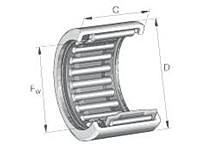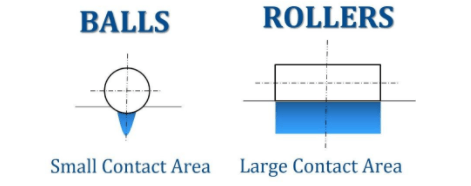Roller Bearings:the high quality wholesale
Roller Bearings:the high quality wholesale
1.What are roller bearings?Types and applications:
Roller Bearings
Roller bearings — also known as rolling-element bearings — are similar to ball bearings in that they are designed to carry a load while minimizing friction. However, roller bearings transmit loads using cylinder rolling elements, rather than balls, to maintain the separation between moving parts of the bearing. These versatile roller bearings can contain single or multiple rows of rolling elements; multiple rows can significantly improve radial load capacity. Also, the use of different roller shapes can further reduce friction and support both radial and axial loads. 
While bearings can handle higher loads than conventional ball bearings, their applications are generally limited to low-speed operations. Many types of roller bearings are self-aligning, and are easily able to overcome misalignment and mounting issues — cutting down on maintenance, repair, and labor needs.
Roller bearings come in a wide range of shapes and sizes, and can be customized for specialized situations. Also, the use of flanges, cages, and multiple bearing rows can allow for higher performance to meet specific applications needs.
Rolling-element bearings have the advantage of a good trade-off between cost, size, weight, carrying capacity, durability, accuracy, friction, and so on. Other bearing designs are often better on one specific attribute, but worse in most other attributes, although fluid bearings can sometimes simultaneously outperform on carrying capacity, durability, accuracy, friction, rotation rate and sometimes cost. Only plain bearings are used as widely as rolling-element bearings. Common mechanical components where they are widely used are – automotive, industrial, marine, and aerospace applications. They are products of great necessity for modern technology.
The rolling element bearing was developed from a firm foundation that was built over thousands of years. The concept emerged in its primitive form in Roman times;[2] after a long inactive period in the Middle Ages, it was revived during the Renaissance by Leonardo da Vinci, developed steadily in the seventeenth and eighteenth centuries.
Roller Bearing Types and Applications
There are thousands of different types of roller bearings available to meet specific application requirements. Emerson Bearing offers a broad selection of roller bearings, including the following popular types:
Cylindrical roller bearings
These roller bearings feature rollers that are longer than their diameter, and can tolerate higher loads than ball bearings. Our cylindrical roller bearings can carry heavy radial loads and are able to be used in high-speed applications.
Spherical roller bearings
These can carry heavy loads even when dealing with misalignment and shaft deflection. They can be designed to have cylindrical or tapered bores for mounting with or without a sleeve adapter. Available with various internal clearances and retainer options, spherical roller bearings can handle axial loading in either direction as well as heavy shock loads. These bearings are available in bore dimensions ranging from 20 mm to 900 mm.
Needle roller bearings
This type of roller bearing is thinner than conventional roller bearings and can be designed with or without an inner ring. Needle roller bearings are ideal for dealing with radial space constraints in heavy-load, high-speed applications. Drawn cup styles allow for high load capacities and large grease reservoirs while still offering a slim cross-section design. These bearings are offered with inch or metric seals.
Taper roller bearings
These roller bearings can support radial and thrust loads. They can only handle unidirectional axial loads, so a second laterally reversed bearing is required for counterstay. Taper roller bearings are available in inch and metric sizes. Roller bearings are used in a wide range of applications, from heavy equipment and machinery to power generation, manufacturing, and aerospace.
2.What are the advantages of roller bearings?
The rolling bearing is a kind of precise mechanical element that turns the sliding friction between the shaft and the axle seat into rolling friction, in order to reduce the friction . Ball bearings, roller bearings and needle roller bearings all belong to the rolling bearings.
Advantages of rolling bearings
1, the friction resistance and the power consumption are small, the mechanical efficiency is high, and is easy to start.
2, size standardization, interchangeability, easy to install and disassemble,easy to repair.
3. The structure is compact, the weight is light, and the axial size is narrower.
4. High precision, large load and long service life.
5. Some bearings have the performance of automatic heart adjustment.
6. It is suitable for mass production, the quality is stable and reliable,and the production efficiency is high.
7, the friction torque of the transmission is much lower than that of the fluid dynamic pressure bearing, so the friction temperature rise and the power consumption are low.
8, the axial size is less than the traditional fluid dynamic bearing.
9. The combined load of radial and thrust can be borne simultaneously.
10. Within a large load – velocity range, the unique bearing design can achieve excellent performance.Disadvantages of rolling bearings
1. The noise is great.
2. The structure of the bearing seat is complex.
3. The cost is high.
4. Even the bearings are lubricated well, installed correctly,well sealed, and the operation is normal, they will eventually fail because of the fatigue of the rolling contact surface.
3.What is the difference between a roller bearing and a ball bearing?
A bearing is a cylindrical unit that is used to provide low-friction movement for a bushing or bearing block. A ball bearing is a spherical unit that accomplishes the same objective as a roller bearing. The real difference has to do with the contact surface between the bearing and the rail.
For ball bearings (assuming a perfectly spherical bearing and no deformation), the contact surface is just a single point. Even once deformation is accounted for, the amount of surface where the ball is contacting the rail is limited. This creates an inherent strength limit for the balls. Roller bearings on the other hand, have an entire line of contact. This greatly increases the rigidity, stability, and maximum load capacity of the system.


